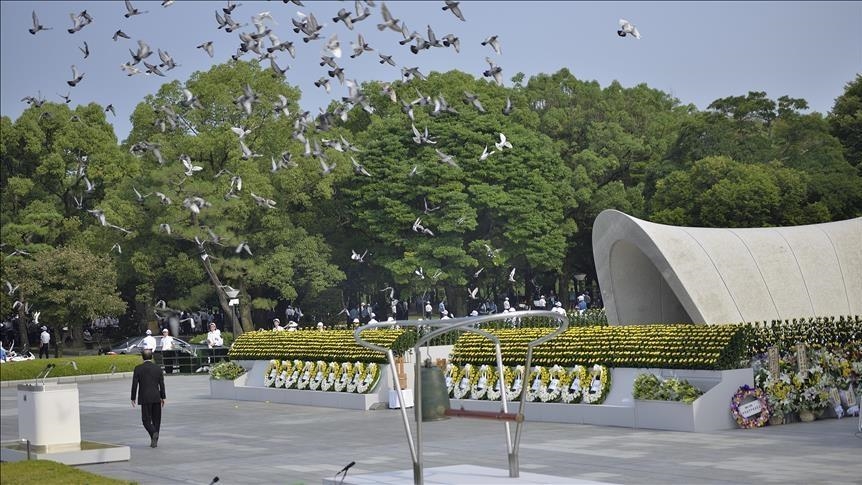INTERVIEW – Echoes from Nagasaki: Survivors warn against devastation of nuclear war
As global threats grow, aging survivors of US atomic attacks on Japan feel growing urgency to remind the world of nuclear war’s horrors

- ‘I want nuclear weapons to be abolished as soon as possible,’ 86-year-old survivor Chiyoko Motomura tells Anadolu
- If there is another world war, ‘far more nuclear weapons than before would be detonated, and there’s a real risk of destroying the planet,’ warns doctor and survivor Masao Tomonaga
- ‘I’m working to make sure a third nuclear weapon is never used. It’s a huge challenge – a challenge for all humanity – but I believe that ordinary people don’t want war,’ says peace activist Tomoko Otaki
ISTANBUL
“The flash was incredible,” says Chiyoko Motomura, an 86-year-old survivor of the US nuclear attack on Nagasaki, recalling the moment that shattered her childhood and left generations grappling with its legacy.
“Soon after, there was the blast wave, the sound of collapsing debris from the heat wave – terrifying sounds – and my small body was thrown on the ground by the blast,” Motomura narrated in a recent conversation with Anadolu, the horror of that fateful day still writ large on her face.
“My grandmother, who was in another part of the house, hurried to me and covered me with her body. At the same time, a glass door crashed down and thin shards of glass flew and pierced my grandmother’s back,” she recalled.
Her grandmother, badly injured, died six months later when Motomura had just finished first grade.
“I’ve lived for 80 years with the thought that if it hadn’t been for me, my grandmother wouldn’t have died. From then on, I thought I must never let today’s children experience what I did. That is the reason why I continue my peace activism,” she said.
Lives shaped by disaster
As global nuclear threats grow, the only way to grasp the visceral horror of nuclear warfare is through the voices of the “hibakusha” – survivors of the US atomic bombings of the Japanese cities of Hiroshima and Nagasaki in 1945.
Today, Motomura, an active member of the Nagasaki Hibakusha Booklet Friendship Association, is among many speaking out with renewed urgency, determined to share their memories as living proof of the human cost of nuclear war.
Dr. Masao Tomonaga, only two years old at the time, has no direct memory of the bombing, but learned about it through his mother’s stories. Their wooden home was located 2.5 kilometers (1.5 miles) from the hypocenter.
“The explosion severely damaged our second floor, with beams and columns falling, but fortunately, my bed was positioned just between the gaps, and I wasn’t injured at all,” he said.
His family fled to a nearby shrine as firestorms engulfed the city. Years later, Tomonaga’s father, a doctor, began treating atomic bomb survivors.
Witnessing firsthand the long-term effects of radiation through his father’s work, Tomonaga became a physician focused on understanding and alleviating the impacts of the bomb.
“When I was in high school, cases of leukemia were still appearing, and I became worried, so I decided to become a doctor,” he said. “Now, I have spent nearly half a century providing medical care to atomic bomb survivors.”
A form of cancer called MDS (myelodysplastic syndrome), similar to leukemia and mostly found in the elderly, began to emerge around the 1980s and continues to appear today, he explained.
“Atomic bomb survivors are affected by radiation exposure throughout their entire lives. We still cannot predict who will get cancer or leukemia, but the effects persist for decades. That is the current understanding,” Tomonaga said.
The average age of atomic bomb survivors is now 86, he said, and many carry pre-cancerous genetic mutations that may eventually lead to cancer.
He also bears witness to the psychological and generational effects of nuclear bombs, noting that despite the survivors’ advanced age, the mental harm of the bombing still lingers.
After seeing the prolonged suffering and uncertainty caused by the bombs, he began a global campaign to spread awareness of the “inhumane nature” of nuclear weapons.
Tomonaga has since lectured globally, advocating for disarmament and education for young people.
He was invited to speak at a forum following the ceremony for the 2024 Nobel Peace Prize, which was awarded to Nihon Hidankyo, a grassroots movement of Japanese atomic bombing survivors. The Nagasaki Hibakusha Booklet Friendship Association, which was established in 1968, is associated with Nihon Hidankyo.
The effects of nuclear exposure are not only physical but also psychological and generational, Tomonaga added.
‘Ordinary people don’t want war’
Tomoko Otaki grew up watching her father struggle with health issues after he survived the bombing.
“He was 17 when he was exposed to the bomb, and I was eight years old when he began his long battle with the aftereffects,” she told Anadolu.
Otaki became a peace advocate later in life, driven by the legacy of survivors and the desire to teach younger generations.
“When I reached around 40 years of age, I looked around and realized that the stories of the atomic bomb and the war, which I had learned as a child, had stayed in my heart and mind,” Otaki added.
In 2018, she began supporting elderly survivors sharing their testimonies internationally, including trips to meet Chernobyl survivors in Ukraine.
“By that time, the average age of atomic bomb survivors had surpassed 80, and many of them felt that, if they were to go abroad to share their stories, it might be their last chance. So, I began supporting these survivors in reaching international audiences,” Otaki said.
“I’m working to make sure a third nuclear weapon is never used. It’s a huge challenge – a challenge for all humanity – but I believe that ordinary people don’t want war. That’s why I think the only way forward is for common people all over the world to connect and join hands,” she said.
New wars, enduring concerns
Tomonaga acknowledged the continued threat of regional conflicts and the fragility of peace, lamenting humanity’s failure to prevent war.
“While a third world war hasn’t occurred yet, smaller conflicts and wars continue to break out,” he said. “Solving this is a major challenge, and I believe the only way is for countries to engage in dialogue and build trust, especially through the UN.”
Calling the Gaza crisis another example of unresolved intergenerational conflict, he stressed the need for dialogue and trust-building among individuals.
He also drew a sharp distinction between conventional conflicts and nuclear war.
“Nuclear weapons are different; they go beyond regional conflict and have the potential to trigger a third world war,” he said. “If that happens, far more nuclear weapons than before would be detonated, and there’s a real risk of destroying the planet.”
“That’s why we must absolutely prevent this from ever happening,” Tomonaga added.
‘Nuclear weapons must be abolished as soon as possible’
The key for a nuclear-free future, according to Tomonaga, lies with the youth of today.
“If young people across borders begin a global movement to abolish nuclear weapons, I truly believe it’s possible,” he said, noting growing enthusiasm from young students.
“The global common people must join hands and work together to demand nuclear abolition from their governments,” he added.
For Motomura, the call for peace is personal and urgent.
“As a hibakusha, I’ve reached the average age of survivors. There isn’t much time left for us,” she said.
Decades after being thrown to the ground by the Nagasaki blast as a child, her memories continue to fuel her passion.
“I feel a great sense of urgency. I want nuclear weapons to be abolished as soon as possible. I want peace to come to the whole world – to the Gaza Strip, to Ukraine. I want everyone to join hands and shout: ‘Let’s stop the wars.’ That’s all I ask,” she said.
Her mission, like those of Tomonaga and Otaki, is clear: to make sure future generations never have to go through what she did.
“I believe that continuing to speak out for peace is my mission in the time I have left,” she said.
Anadolu Agency website contains only a portion of the news stories offered to subscribers in the AA News Broadcasting System (HAS), and in summarized form. Please contact us for subscription options.





